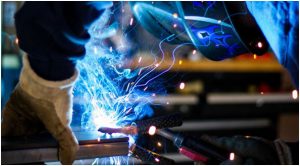Some very good signs of recovery are visible for the welding industry. The increasing infrastructure projects are a huge opportunity for consolidation of its business. India seems almost in line with the international markets and the future seems rather optimistic. Today, India is much better poised and in a very comfortable position when compared to the last three years despite the pandemic. The current government has introduced schemes to boost the industry, the major contributor being the ‘Make in India’ campaign.
India had to suffer recession during 2007-13, but slowly, it is coming out of the recession, though could not do it 100 per cent. There are healthy signs of recovery for the manufacturing sector and also for the welding industry. With the inflation rate slowly but steadily falling it will provide opportunities for reduced interest rate from the lenders. This will spur the growth and the introduction of the GST will eliminate the multi tax problems, which would further encourage the industry to focus on upgradation and adoption of newer technologies. From the last quarter of 2017 onwards, we hope to have much better progress in the segment and related industries.
Currently, India is the second largest steel manufacturer, probably, just catching up with Japan. The sector produces between 95 and 100 million tonnes of steel every year. Out of which, around three million metric tonnes of steel is used for welding materials. The government has set a target of producing 250 million metric tonnes of steel in India by 2020-2022. With the set target, it can be safely said that there is a huge market for the welding industry within India.
The government has instructed all its departments to complete the listed projects before 2022. This strengthens our view of extraordinary growth potential in India and also reaffirms the welding industry projection of about 6-7 per cent growth over the previous years, which is in line with the international manufacturers.

Although it will be improper to say that India is lagging behind in the welding sector, we definitely need to upgrade ourselves. In this regard it can be said that the Indian automobile sector is definitely closer to the international market in terms of quality. In fact, today, the international automobile companies are keen to have a foothold in the Indian market. So, we can say that we are competing with the world in this segment, but in terms of heavy engineering, we still need a lot of infrastructure support and technology. However, to our great misfortune, there is no basic welding research facility in India, except the Welding Research Institute (WRI) in Tiruchirappalli. WRI is a premier arm of the BHEL Research Centre of India in the field of welding and allied areas. It is imperative that we have a government established or government-aided welding research centre.
The government has opened up huge opportunities through public private partnership (PPP) projects, starting with the defence sector. It is expected that in the years to come, the atomic energy and aerospace segments will also boost the welding industry. However, the industry is facing lot of challenges. The primary challenge is the technological gap between India and the international market. Another challenge is the non-availability of skilled manpower, which is a concern not only in India but also globally. The entire welding, fabrication and other allied segments are facing this issue. Against this background, Prime Minister Modi, through his Skill India project, is focusing largely to boost skilled man power in India.
Among the Asian countries, Japan and Korea are leading in the welding segment. China also has a very strong presence in the segment. Canada, USA and Germany are the other countries largely focusing on welding. India is definitely not lagging behind. Several top welding companies are located in India. Various sectors in India like the aerospace, automobile, infrastructure, etc have started taking a positive turn. The power sector still needs to play catch-up. The state-owned power plants are running at an average efficiency of 40 – 45 per cent, which is a huge area of concern. Similarly, the transport sector also needs to upgrade.
Shipping is one area wherein we need to increase our welding activities, since India has the largest coastal line in the subcontinent. So far, we have not explored the possibilities existing along the coastal line by setting up a large number of ship-repairing workshops or shipyards.
The act of welding is not the only important part, even the material that goes into welding is very important because India is a country with a variety of temperatures and climate. This leads to challenges and we have to overcome them. Advancements in technology is needed to reduce the manufacturing time. As and when the manufacturing and delivery time is cut down, manufacturers can achieve profitability. Hence, a lot of automation has already been introduced in India and it will only increase in the days to come.
Robotic welding techniques obviously offer a much clear and qualitative output. In India, most of the companies, who manufacture such equipment, depend on small vendors. These vendors also have to equally upgrade themselves at par with the quality of the company to which they offer their products. Hence, to attain that level, a lot of funding is required. Today, the Micro, Small and Medium Enterprises (MSMEs) have lot of facilities, schemes, and incentives to upgrade themselves. The industry players need to take initiative and a big step towards technological upgradation of their facilities to meet the global needs and challenges.



